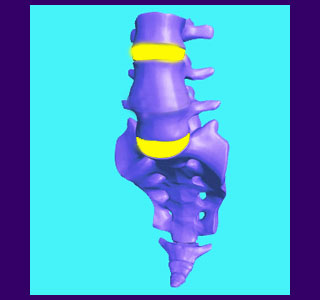
Naturally fused vertebrae can exist anywhere in the backbone and are actually a rather common type of spinal abnormality. Natural spinal fusions can occur from several different source processes and might have a variety of effects on the remainder of the vertebral column, depending on many factors.
When most people hear the words spinal fusion, they immediately think of spondylodesis surgery. This is a procedure in which one or more intervertebral discs are removed from the spine from in between 2 or more vertebrae and the bones are then joined using organic bone grafts, synthetic bones grafts and/or reinforcing hardware. This is one of the most invasive, complication-fraught and difficult to endure operations possible to undergo for any patient.
However, the focus on this exploratory article is spinal fusion that occurs organically. We will detail the causes of naturally fused vertebrae, the locations where it can occur and the possible consequences to the patient, when it does occur.
Naturally Fused Vertebrae Explained
Spinal fusion describes any scenario wherein 2 or more vertebrae come together to form a solitary solid mass of bone, rather than 2 or more individual component pieces. As previously mentioned, this anatomical result is the desired effect of spondylodesis surgery, but can also happen through purely organic means. The latter causation is the subject of the remainder of this essay.
Vertebrae are usually insulated and separated from one another by a soft tissue spacer called an intervertebral disc. The very name intervertebral is defined as meaning “in between the vertebrae”, which is where these discs reside in the spinal anatomy.
The spinal discs keep the bones apart and cushion them from interacting together. This prevents the bone-on-bone contact that is commonly seen in older people when the discs naturally degenerate, desiccate and shrink, causing the variety of structural skeletal change known as osteoarthritis.
Spinal discs also facilitate movement in the spinal column, allowing some degree of individual motion from one vertebral bone to the next. Over the course of the entire backbone, the spinal discs allow tremendous range of motion when the individual movement parameters of all the vertebral levels are combined.
Finally, the spinal discs add height to the spine, accounting for a significant percentage of its overall length. Since the discs deteriorate with age, this explains why most of us get shorter as we get older.
The absence of an intervertebral disc in between 2 vertebrae is called a fusion. This means that the bone connects directly to the bone above, below or both, without the benefit of a spinal spacer at the affected level(s) of the backbone. In the case of organic spinal fusion, this occurrence happens naturally and is not the result of surgical intervention, such as in the spondylodesis procedure detailed above.
Varieties and Causes of Natural Vertebral Fusion
There are 2 main categories of organic vertebral fusion that can and do occur regularly in the human spine:
Congenital spinal fusion describes an inborn trait of the vertebral column wherein the person is literally born with a spine that features one or more vertebral fusions at birth. In essence, the intervertebral disc at a particular location or locations never develops.
Developed natural spinal fusions are not inborn, but instead come to being over time, usually due to degeneration and possible injury. Many factors can cause typical spinal bones to fuse naturally, including any and all of the following factors:
Extreme degenerative disc disease may make the intervertebral spacer virtually disappear, providing absolutely no cushion between vertebral bones. This can facilitate natural fusion over time. It must be noted that although this case profile of disc degeneration is severe, the process of disc desiccation is completely normal and universal.
Osteoarthritis can certainly facilitate natural vertebral fusions in the spine. OA is a universal result of disc degeneration and typical spinal aging.
Atypical spinal curvatures can increase pressure within regions of the spine, facilitating increased chances for partial or full natural spinal fusions. This can occur with both side-to-side curvatures, like scoliosis, as well as atypical front-to-back curvatures, such as hyperlordosis, hypolordosis, hyperkyphosis and hypokyphosis.
Acute spinal disc rupture, extrusion and sequestration can leave an intervertebral space devoid of any spacer at all, facilitating natural spinal fusion. This can occur due to degeneration of the spinal disc or acute traumatic injury.
Locations for Naturally Fused Vertebrae
Naturally fused vertebrae can occur virtually anywhere in the spine, with the exception of the sacrum and the coccyx, which already demonstrate organic fusion of the vertebral bones by natural design in a typical anatomy.
Natural fusions may occur in the neck and are often found in combination with disc degeneration, severe osteoarthritis and possible compression fractures of vertebral bones.
Natural vertebral fusions can be located in the upper and middle thoracic levels and are often seen in combination with scoliosis, hyperkyphosis or as the results of massive traumatic injury to the mostly stable thoracic region. Natural fusions in the thoracic spine statistically have the least chance of being diagnosed, since this area is not called upon to move in the same manner as the other regions of the vertebral column.
The lumbar region is the most commonly affected area that may demonstrate organic vertebral fusion. Once again, the changes are often seen in combination with marked disc desiccation, osteoarthritis. Possible compression fractures may exist and the rate of intervertebral herniation is high in patients who go on to express an organic fusion, especially at L4/L5 and L5/ S1.
When the final vertebral bone in the lumbar spine is fused to the sacrum, this is called a sacralized vertebra. This is just a name for a particular location of natural fusion in the lower spine and is not different than any other variety of organic bone joining.
Naturally Vertebral Fusion Risk Factors
Risk factors for acquiring a natural vertebral fusion include unusually high levels of spinal degeneration, such as those often demonstrated by some types of athletes and those with genetic predisposition to unusual degrees of disc and bone deterioration.
Obese people are much more likely to suffer natural fusions, due to the massive weight compacting already compromised spinal structures into one another. In virtually all cases of compression fractures leading to natural fusions, the patient is usually either very old, morbidly obese or both.
The elderly are more susceptible to natural fusion formation, since their spinal discs have endured decades of marked deterioration, leaving their vertebrae arthritic, sometimes soft and occasionally, pressed directly together, forming the ideal circumstances for natural fusions to take place.
Consequences of Naturally Fused Vertebrae
The effects of naturally fused vertebrae range greatly, depending on particular patient criteria and location of the joining. Single level natural fusions are virtually never problematic, regardless of where they exist in the spine, as long as the central and neuroforaminal canals remain patent during the formation of the fusion.
Multiple levels of fusion might become problems, since they exert increased force against the remainder of the spine, especially affecting nearby vertebral levels above and below. The more levels become naturally fused, the worse these effects typically are. Some possible results of multiple level organic fusions include any or all of the following:
Back or neck pain is possible and may occur from many possible mechanisms.
Spinal or foraminal stenosis is likely to occur with multiple levels of organic fusion, although this is not a rule.
Multilevel fusions might reshape the spinal anatomy, causing scoliosis or creating lordotic or kyphotic changes to the immediate area or the entire backbone length.
Some organic fusions might increase the incidence of suffering fracture at the fused locations or nearby. Natural fusions that occur in people with porous bones or osteomalacia are especially dangerous and often break repeatedly, causing pain and possible spinal instability.
Multiple level fusions will almost certainly diminish overall flexibility and may reduce physical functionality substantially in some patients.
Multiple level natural spinal fusions may increase force in the spine and enhance any trauma suffered, since there will be less flex from level to level and less shock absorption capability to the entire backbone structure.
For a complete description of a diagnosed natural spinal fusion condition, be sure to undergo a variety of specialized imaging techniques and then consult with a neurologist and orthopedist for accurate prognostic evaluation.






